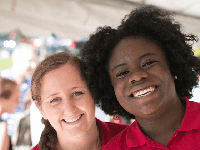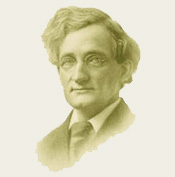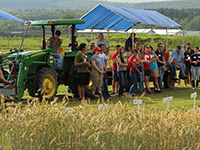Home | Unit 3
Overview
In this activity, youth work together to produce a short 4-5-minute video showcasing people in their community who are making a difference by taking action toward climate change.
Skill Level
Intermediate/Advanced; Beginner level with adult assistance
Learner Outcomes, Youth will:
- Apply existing knowledge about climate change mitigation practices
- Understand and identify alternative methods of climate change mitigation practices
- Demonstrate ways that others and themselves can adopt climate change mitigation practices
- Apply critical thinking skills to identify a problem and pose questions for investigation
- Use web-based resources to research and identify methods of climate change mitigation practices
- Collaborate in small groups and take on specific roles to produce and present a video production
Education Standards
- NL-ENG.K-12.6 Applying Knowledge: Create and critique nonprint texts.
- NT.K-12.3 Technology Productivity Tools: Enhance learning, promote creativity.
- NT.K-12.4 Technology Communication Tools: Collaborate, publish, and interact with peers, experts, and other audiences.
Success Indicators
Demonstrate how others and themselves embrace climate change mitigation practices.
Life Skills
Teamwork, marketable/useful skills, contribution to the group, planning/organizing, communication
Time Needed
Varies according to group size, allow for multiple sessions and virtual meeting time.
Materials List: Photo release and other participation forms, devices with Internet access and video development and presentation capability, sticky note pad and poster boards for each small group, pens, markers, Storyboard Planning template, one for each person.
Youth Handout
Space
Appropriate room to accommodate meeting in small groups, to set up planning, project locations to interview community members, place to present videos to the whole group.
Suggested Group Size
12-15 or more, small groups of 4 or 5
Acknowledgments
Adapted from “What Do we Do With All That Trash” lesson by Donna Alese Cooke, April 2, 2011
Introduction
Actions to address climate change is a topic of growing interest among youth throughout the world. In this activity we will explore ways, both big and small that people they know in their communities are addressing climate change issues and reducing their carbon footprint.
The goal of this activity is to have youth work together to produce a short 4-5-minute video showcasingpeople in their community who are making a difference by taking action toward climate change. Prior to this activity, it is suggested that your group complete prior activities 3.1: Action Takers, 3.2: Peer Interviews, and 3.3: Practice Interview in sequence, as they are experiential steps leading up to the final preparation and presentation of the video project.
Opening Questions
- Reflecting on what you’ve watched in the videos in 3.1 Action Takers, and imagining your way into creating your own video to inspire others, what and who would you feature? What would be the look and feel of the video?
- Who in your community is making a difference in doing something about climate change? How might you find out?
- What questions would you ask those in your community you will interview for the video?
- How will you know if your video has inspired others to action?
Background Information
Before the Activity
Prepare materials and handouts. Provide or suggest devices (mobile phone, tablet, laptop) with Internet access and video capability. Participants may provide their own or use a computer lab at school or in the library. Review introductory videos.
Let’s Do It!
Introduce the activity: People Taking Action
- Review the introductory videos in 3.1 Action Takers activity. Ask opening questions as they relate to the videos.
- Explain to youth that they will work in small teams to plan, produce and present a 4-5-minute video presentation.
- Provide each team with a poster board, pads of colored sticky notes, pens and markers. Ask them to create a planning process and storyboard on their poster boards.
Part One
Brainstorm Project Plan. Model the planning process by using the Brainstorming and Storyboard handout and have them use sticky notes to jot down ideas and add to the storyboard.
- Style: How the content, video filming technique, style and approach in the video examples they watched 1.1 and may work in creating their video?
- Who will be the subject of their interview and video?
- What possible interview questions will they ask?
Playing Your Part. Each member in the small group will be assigned a task (smaller groups may have more than one task per member): writer, host, videographer, director, and producer. Decide who will be doing each task:
- writer: finalizes the interview questions and will work with the producer to write the first and final draft of the storyboard.
- producer: works with the writer on the storyboard and makes sure all other group members are fulfilling their tasks.
- director: the director will follow the storyboard and direct the videographer and host(s) throughout the videotaping process.
- host (front of the camera): the host will be the person narrating the video, interviewing and showcasing the subject’s demonstration of their actions against climate change. This task can also be shared by all members (other than the videographer) should the writer, producer and director want to host a segment in the video.
- videographer: the videographer shoots all the video scenes, follows the storyboard and works alongside the director and host to make any edits before publishing the video onto the site.
Final Revisions. After the writer and producer complete the first draft of the storyboard, they will present it to the group to discuss and make final revisions before moving on to Part Two.
Part Two
Video Production and Debut. Along with adult supervision, each small group will reach out to the interviewee(s) to see if they will agree to be a subject of the video shoot; once a subject agrees:
- Revise and finalize the interview questions if more personalization is needed.
- Have interviewee(s) fill out any photo release forms for permission.
- Schedule a time, place to tape the interview.
All group members will be on ‘location’ during the video shoot, using the storyboard and interview questions as a guide. Videos will conclude with small group members adding commentary about how these people in their community have inspired them to make positive change as well. Groups will meet to review the video for editing and finalizing.
Conclusion: Talk It Over
Share
- Each group will present their videos (timing, how, where TBD).
- How did the production roles help with this video project?
Reflect
Which person(s) featured in the videos inspired you? How?
Generalize
What are the big and small changes have people interviewed in the videos accomplished (introductory videos and those produced in this activity)?
Apply
How do you see yourself taking action in the same way the leaders in your community are? What ways can you continue showing others in your community how to take action? What are some actions you will take today to act against climate change?
References
- New Brunswick 4H project for the Climate Change Summit Community Compost Project for their community garden.
- Changing our behavior is one way we can make a difference in Climate Change. TrashFash is a 4-H Teen Climate Summit project in which a group of kids came together to make upcycled items to sell at the Cape May County 4-H Fair.
- Pin Oak home-school group’s climate change video.
- Virginia environmental conservation organization is teaching local school children from Grandby High School, climate resilience strategies to live with rising waters.
- ACE Educator Elana, explores her own nearby community garden and takes a look at how some local high school students grow their own food to reduce carbon emissions.









